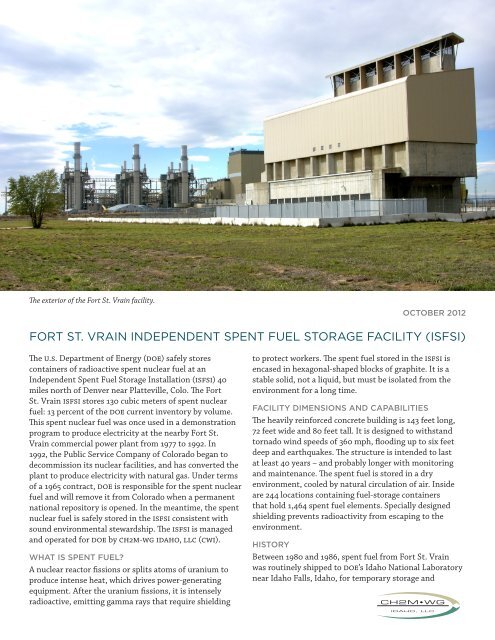fort st. vrain independent spent fuel storage facility - Idaho Cleanup ...
fort st. vrain independent spent fuel storage facility - Idaho Cleanup ...
fort st. vrain independent spent fuel storage facility - Idaho Cleanup ...
Create successful ePaper yourself
Turn your PDF publications into a flip-book with our unique Google optimized e-Paper software.
The exterior of the Fort St. Vrain <strong>facility</strong>.<br />
OCTOBER 2012<br />
FORT ST. VRAIN INDEPENDENT SPENT FUEL STORAGE FACILITY (ISFSI)<br />
The u.s. Department of Energy (doe) safely <strong>st</strong>ores<br />
containers of radioactive <strong>spent</strong> nuclear <strong>fuel</strong> at an<br />
Independent Spent Fuel Storage In<strong>st</strong>allation (isfsi) 40<br />
miles north of Denver near Platteville, Colo. The Fort<br />
St. Vrain isfsi <strong>st</strong>ores 130 cubic meters of <strong>spent</strong> nuclear<br />
<strong>fuel</strong>: 13 percent of the doe current inventory by volume.<br />
This <strong>spent</strong> nuclear <strong>fuel</strong> was once used in a demon<strong>st</strong>ration<br />
program to produce electricity at the nearby Fort St.<br />
Vrain commercial power plant from 1977 to 1992. In<br />
1992, the Public Service Company of Colorado began to<br />
decommission its nuclear facilities, and has converted the<br />
plant to produce electricity with natural gas. Under terms<br />
of a 1965 contract, doe is responsible for the <strong>spent</strong> nuclear<br />
<strong>fuel</strong> and will remove it from Colorado when a permanent<br />
national repository is opened. In the meantime, the <strong>spent</strong><br />
nuclear <strong>fuel</strong> is safely <strong>st</strong>ored in the isfsi consi<strong>st</strong>ent with<br />
sound environmental <strong>st</strong>ewardship. The isfsi is managed<br />
and operated for doe by ch2m-wg idaho, llc (cwi).<br />
WHAT IS SPENT FUEL<br />
A nuclear reactor fissions or splits atoms of uranium to<br />
produce intense heat, which drives power-generating<br />
equipment. After the uranium fissions, it is intensely<br />
radioactive, emitting gamma rays that require shielding<br />
to protect workers. The <strong>spent</strong> <strong>fuel</strong> <strong>st</strong>ored in the isfsi is<br />
encased in hexagonal-shaped blocks of graphite. It is a<br />
<strong>st</strong>able solid, not a liquid, but mu<strong>st</strong> be isolated from the<br />
environment for a long time.<br />
FACILITY DIMENSIONS AND CAPABILITIES<br />
The heavily reinforced concrete building is 143 feet long,<br />
72 feet wide and 80 feet tall. It is designed to with<strong>st</strong>and<br />
tornado wind speeds of 360 mph, flooding up to six feet<br />
deep and earthquakes. The <strong>st</strong>ructure is intended to la<strong>st</strong><br />
at lea<strong>st</strong> 40 years – and probably longer with monitoring<br />
and maintenance. The <strong>spent</strong> <strong>fuel</strong> is <strong>st</strong>ored in a dry<br />
environment, cooled by natural circulation of air. Inside<br />
are 244 locations containing <strong>fuel</strong>-<strong>st</strong>orage containers<br />
that hold 1,464 <strong>spent</strong> <strong>fuel</strong> elements. Specially designed<br />
shielding prevents radioactivity from escaping to the<br />
environment.<br />
HISTORY<br />
Between 1980 and 1986, <strong>spent</strong> <strong>fuel</strong> from Fort St. Vrain<br />
was routinely shipped to doe’s <strong>Idaho</strong> National Laboratory<br />
near <strong>Idaho</strong> Falls, <strong>Idaho</strong>, for temporary <strong>st</strong>orage and
te<strong>st</strong>ing. However, in October of 1991, political and tribal<br />
opposition in <strong>Idaho</strong> halted the shipments, followed by<br />
lawsuits in federal court. An agreement in principle<br />
between doe and Public Service Company was reached in<br />
1995, and an out-of-court settlement was adopted in 1996.<br />
doe took title to the <strong>spent</strong> <strong>fuel</strong> and became responsible for<br />
managing its temporary <strong>st</strong>orage at the Fort St. Vrain site.<br />
EMERGENCY PREPAREDNESS<br />
The Fort St. Vrain isfsi conducts emergency preparedness<br />
drills as often as monthly and takes part in a full-scale<br />
emergency exercise every two years, as required by its<br />
Nuclear Regulatory Commission license. Emergency<br />
response personnel from both <strong>Idaho</strong> and Colorado<br />
participate in the exercise, as well as regional law<br />
enforcement and hospitals.<br />
Such drills and exercises are conducted to prepare<br />
personnel for a possible emergency at the isfsi and to<br />
te<strong>st</strong> the communication channels among the doe, its<br />
contractor, and offsite emergency and medical support.<br />
The media often report when drills or exercises are being<br />
conducted as a public service.<br />
CONTACT INFORMATION<br />
Erik Simpson<br />
ch2m-wg idaho, llc<br />
Erik.Simpson@icp.doe.gov<br />
Office: 208-360-0426<br />
Spent nuclear <strong>fuel</strong> safely <strong>st</strong>ored in secure dry <strong>st</strong>orage units.




